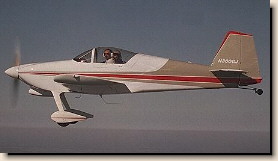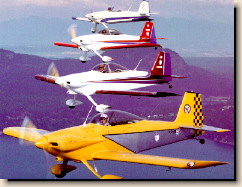|
Introduction -
About RV Kitplanes
Aircraft,
Inc. has been a leading supplier of aircraft kits
since 1973. Our first offering was the single place
RV-3. Its outstanding performance gained an enthusiastic
following. This popularity naturally led to a customer
demand for, and the development of, a two-place airplane.
Tandem seating was chosen for the RV-4 because of
the lower drag, superior centerline visibility, lighter
weight, and overall fighter-like sportiness. It was
a combination well suited to the market it entered
in 1981. With performance nearly that of the RV-3
and an extra seat as well, the RV-4 became an immediate
favorite and soon surpassed the RV-3 in popularity.
In the early to mid 1980s,
the homebuilt market began to shift toward efficient touring, rather than pure sport airplanes. In response
to this demand Van’s developed the side-by-side
RV-6. Careful design and attention to aerodynamic
details resulted in a new airplane that retained the
delightful handling and short field qualities of the
RV-4, and despite the wider fuselage, had a top speed
only 3 mph less. The trigear RV-6A was developed from
the RV-6 to better fill the needs of the modern pilot.
The addition of the nosewheel reduces the top speed
only 2 mph.
touring, rather than pure sport airplanes. In response
to this demand Van’s developed the side-by-side
RV-6. Careful design and attention to aerodynamic
details resulted in a new airplane that retained the
delightful handling and short field qualities of the
RV-4, and despite the wider fuselage, had a top speed
only 3 mph less. The trigear RV-6A was developed from
the RV-6 to better fill the needs of the modern pilot.
The addition of the nosewheel reduces the top speed
only 2 mph.
In 1995, Van’s flew the prototype RV-8, a
new tandem design incorporating improvements learned from years of experience with the
RV-4 and RV-6/6A. With a wider cockpit than the RV-4, two baggage compartments and
increased instrument panel space, the RV-8 offers greater cross-country comfort without
compromising the fighter-like sportiness of centerline seating. The RV-8 was designed to
handle engines of 150-200 hp, and with the 200 hp IO-360 Lycoming, it sustains cruise
speeds of 212 mph. Top speed is 222 mph. Naturally, the next question is: what about an
RV-8A? The answer is, yes, of course! The RV-8A made its first flight in April 1998 and
kits were available soon after.
The RV-9A, a side-by-side tricycle-gear design
similar to the RV-6A, was first flown in December 1997. Designed to use lower-powered
engines, the RV-9A is an alternative to those needing a "bigger, faster, more
powerful" airplane. The first subkit was made available in November
1999.
At the 1997 EAA
Convention in Oshkosh, WI, 288 RVs flew in to celebrate the 25th anniversary of Van’s
first Oshkosh arrival in his RV-3. Completions now average about five per week. Since many
projects were started within the past year or two, even larger numbers will be flying
soon. The RV phenomenon is not restricted to the USA; builders all over the world have
recognized the excellent value these airplanes offer. RV kits have been shipped to over 40
countries, and are actually flying in 20, as diverse as Greece, Australia and Nigeria.
By late 1999 more than 2300 RV kits had been
completed and flown, and at least 5000 more were under construction.
Total Performance,
a term coined to describe the RVs, refers to their
wide performance  envelope
and sporty handling qualities. While the RVs are excellent
cross-country airplanes, they are not simply "go-fast"
machines. They are also aerobatic and have outstanding
low speed characteristics and short-field capabilities;
a rare combination. First and foremost, though, they
are fun to fly. Their controls are light, responsive,
and beautifully harmonized. Chances are that you have
never flown an airplane that offers anything approaching
the exhilarating sensation of an RV. envelope
and sporty handling qualities. While the RVs are excellent
cross-country airplanes, they are not simply "go-fast"
machines. They are also aerobatic and have outstanding
low speed characteristics and short-field capabilities;
a rare combination. First and foremost, though, they
are fun to fly. Their controls are light, responsive,
and beautifully harmonized. Chances are that you have
never flown an airplane that offers anything approaching
the exhilarating sensation of an RV.
RVs are aluminum monocoque structures. The
aluminum skins are supported by an internal structure of ribs, spars, and bulkheads, just
like production light aircraft. Conventional "AN" aircraft rivets are used to
fabricate the aluminum structure. The cowling, wing tips, wheel fairings and similar
non-structural fairing parts are made of fiberglass.
Along with performance and handling, creature
comfort was given high priority in the RV designs. Cockpits have been sized to comfortably
accept pilots up to 6'4'' (slightly taller people can be accommodated in the RV-6 and RV-4
by making minor cockpit modifications, and the standard RV-8/8A will fit even if
you’re 6’6" or more). Adding to the comfort (and safety) is the outstanding
visibility enjoyed by all the RVs. The bubble canopies offer unrestricted in-flight
visibility. Ground visibility is so good that little or no S-turning is needed while
taxiing.
|